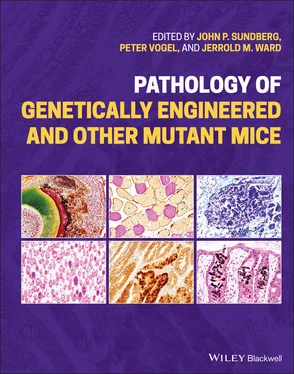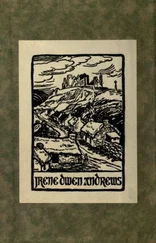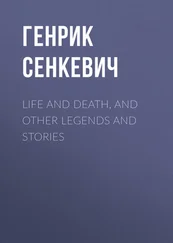Pathology of Genetically Engineered and Other Mutant Mice
Здесь есть возможность читать онлайн «Pathology of Genetically Engineered and Other Mutant Mice» — ознакомительный отрывок электронной книги совершенно бесплатно, а после прочтения отрывка купить полную версию. В некоторых случаях можно слушать аудио, скачать через торрент в формате fb2 и присутствует краткое содержание. Жанр: unrecognised, на английском языке. Описание произведения, (предисловие) а так же отзывы посетителей доступны на портале библиотеки ЛибКат.
- Название:Pathology of Genetically Engineered and Other Mutant Mice
- Автор:
- Жанр:
- Год:неизвестен
- ISBN:нет данных
- Рейтинг книги:3 / 5. Голосов: 1
-
Избранное:Добавить в избранное
- Отзывы:
-
Ваша оценка:
- 60
- 1
- 2
- 3
- 4
- 5
Pathology of Genetically Engineered and Other Mutant Mice: краткое содержание, описание и аннотация
Предлагаем к чтению аннотацию, описание, краткое содержание или предисловие (зависит от того, что написал сам автор книги «Pathology of Genetically Engineered and Other Mutant Mice»). Если вы не нашли необходимую информацию о книге — напишите в комментариях, мы постараемся отыскать её.
An updated and comprehensive reference to pathology in every organ system in genetically modified mice Pathology of Genetically Engineered and Other Mutant Mice
Pathology of Genetically Engineered and Other Mutant Mice
Pathology of Genetically Engineered and Other Mutant Mice — читать онлайн ознакомительный отрывок
Ниже представлен текст книги, разбитый по страницам. Система сохранения места последней прочитанной страницы, позволяет с удобством читать онлайн бесплатно книгу «Pathology of Genetically Engineered and Other Mutant Mice», без необходимости каждый раз заново искать на чём Вы остановились. Поставьте закладку, и сможете в любой момент перейти на страницу, на которой закончили чтение.
Интервал:
Закладка:
Use of Mouse Pathology Resources on Line; Citations, and Licenses
The availability of the wide range of resources discussed in this chapter is subject to the constraints of funding and user interactions, and there will inevitably be turnover as existing databases cease and new ones emerge. Funding patterns are very different for all of the resources discussed above, some are well‐funded and supported institutionally, while others run on a wing and a prayer. The importance of even small databases to particular specialties or communities is, however, not necessarily related to their scale or the size of their funding and it is the role that they play which is important.
What makes a data resource succeed is interaction with its users. Submission of data for those that act as archives, feedback, and contact for all, but specifically making sure that databases are cited in papers if they were used in the work, even though images may not have been actually included in papers. The use of data resources far outstrips citations; this is a known aspect of running databases, yet funding agencies like to see citations and this will help the database you use to stay afloat. All databases have advice on how to cite them and we would encourage everyone in the community to remember to cite databases that have been of use in training or in writing original manuscripts.
The second issue of note is the license under which images and data are distributed. Most data and images are distributed under a Creative Commons CC‐BY license that permits data to be used, redistributed, and modified as long as the original source is always cited. The CC‐BY‐ND, that is less often used, prohibits the making of derivatives so that means that you cannot redistribute the image modified in any way. Finally, CC‐0 is effectively a waiver on rights so that the image or data are distributed to the public domain. These licenses are legally actionable, though the authors are currently unaware of any actions being taken under these licenses for histopathology images. It is, however, useful to know what each means and act accordingly. We would encourage all data and images put into the public domain to be released according to, at least, a CC‐BY license if not CC‐0, for the benefit of the community.
Acknowledgments
This work was supported in part by a grant from the Erasmus + Knowledge Alliance of the Education, Audiovisual and Culture Executive Agency (EACEA) of the European Union (Reference Number 600803‐EPP‐1‐2018‐1‐ES‐EPPKA2) and grants from the National Institutes of Health (CA089713 and CA034196).
References
1 1 Durinx, C., McEntyre, J., Appel, R. et al. (2017). Identifying ELIXIR core data resources. F1000 Res. 5: 2422.
2 2 Sansone, S.A., McQuilton, P., Rocca‐Serra, P. et al. (2019). FAIRsharing as a community approach to standards, repositories and policies. Nature Botechnol. 37 (4): 358–367.
3 3 Pampel, H., Vierkant, P., Scholze, F. et al. (2013). Making research data repositories visible: the re3data.org registry. PLoS One 8 (11): e78080.
4 4 Bult, C.J., Blake, J.A., Smith, C.L. et al., Mouse Genome Database Group (2019). Mouse Genome Database (MGD) 2019. Nucleic Acids Res. 47 (D1): D801–D806.
5 5 Smith, C.M., Hayamizu, T.F., Finger, J.H. et al. (2019). The mouse Gene Expression Database (GXD): 2019 update. Nucleic Acids Res. 47 (D1): D774–D779.
6 6 Heffner, C.S., Herbert Pratt, C., Babiuk, R.P. et al. (2012). Supporting conditional mouse mutagenesis with a comprehensive cre characterization resource. Nat. Commun. 3: 1218.
7 7 Lovering, R.C., Roncaglia, P., Howe, D.G. et al. (2018). Improving interpretation of cardiac phenotypes and enhancing discovery with expanded knowledge in the Gene Ontology. Circ Genom Precis Med. 11 (2): e001813.
8 8 Hill, D.P., D'Eustachio, P., Berardini, T.Z. et al. (2016). Modeling biochemical pathways in the gene ontology. Database 2016: baw126.
9 9 Gene Ontology, C., Blake, J.A., Dolan, M. et al. (2013). Gene Ontology annotations and resources. Nucleic Acids Res. 41 (Database issue): D530–D535.
10 10 Thomas, P.D., Wood, V., Mungall, C.J. et al., Gene Ontology Consortium (2012). On the use of gene ontology annotations to assess functional similarity among orthologs and paralogs: a short report. PLoS Comput. Biol. 8 (2): e1002386.
11 11 Blake, J.A. and Harris, M.A. (2008). The Gene Ontology (GO) project: structured vocabularies for molecular biology and their application to genome and expression analysis. Curr. Protoc. Bioinformatics;Chapter 7:Unit 7.2.
12 12 Krupke, D.M., Begley, D.A., Sundberg, J.P. et al. (2017). The Mouse Tumor Biology Database: a comprehensive resource for mouse models of human cancer. Cancer Res. 77 (21): e67–e70.
13 13 Begley, D.A., Sundberg, J.P., Krupke, D.M. et al. (2015). Finding mouse models of human lymphomas and leukemia's using the Jackson laboratory mouse tumor biology database. Exp. Mol. Pathol. 99 (3): 533–536.
14 14 Bult, C.J., Krupke, D.M., Begley, D.A. et al. (2015). Mouse Tumor Biology (MTB): a database of mouse models for human cancer. Nucleic Acids Res. 43 (Database issue): D818–D824.
15 15 Begley, D.A., Krupke, D.M., Neuhauser, S.B. et al. (2014). Identifying mouse models for skin cancer using the Mouse Tumor Biology Database. Exp. Dermatol. 23 (10): 761–763.
16 16 Conte, N., Mason, J.C., Halmagyi, C. et al. (2019). PDX Finder: a portal for patient‐derived tumor xenograft model discovery. Nucleic Acids Res. 47 (D1): D1073–D1079.
17 17 Motenko, H., Neuhauser, S.B., O'Keefe, M., and Richardson, J.E. (2015). MouseMine: a new data warehouse for MGI. Mamm. Genome 26 (7–8): 325–330.
18 18 Smith, C.L. and Eppig, J.T. (2015). Expanding the mammalian phenotype ontology to support automated exchange of high throughput mouse phenotyping data generated by large‐scale mouse knockout screens. J. Biomed. Semantics 6: 11.
19 19 Bello, S.M., Shimoyama, M., Mitraka, E. et al. (2018). Disease Ontology: improving and unifying disease annotations across species. Dis. Model. Mech. 11 (3): dmm032839.
20 20 Kohler, S., Doelken, S.C., Mungall, C.J. et al. (2014). The Human Phenotype Ontology project: linking molecular biology and disease through phenotype data. Nucleic Acids Res. 42 (Database issue): D966–D974.
21 21 Amberger, J.S., Bocchini, C.A., Scott, A.F., and Hamosh, A. (2019). OMIM.org: leveraging knowledge across phenotype‐gene relationships. Nucleic Acids Res. 47 (D1): D1038–D1043.
22 22 Mungall, C.J., McMurry, J.A., Kohler, S. et al. (2017). The Monarch Initiative: an integrative data and analytic platform connecting phenotypes to genotypes across species. Nucleic Acids Res. 45 (D1): D712–D722.
23 23 Alliance of Genome Resources Consortium (2019). The Alliance of Genome Resources: building a modern data ecosystem for model organism databases. Genetics 213 (4): 1189–1196.
24 24 Begley, D.A., Krupke, D.M., Neuhauser, S.B. et al. (2012). The Mouse Tumor Biology Database (MTB): a central electronic resource for locating and integrating mouse tumor pathology data. Vet. Pathol. 49 (1): 218–223.
25 25 Begley, D.A., Krupke, D.M., Vincent, M.J. et al. (2007). Mouse Tumor Biology Database (MTB): status update and future directions. Nucleic Acids Res. 35 (Database issue): D638–D642.
26 26 Bult, C.J., Krupke, D.M., Sundberg, J.P., and Eppig, J.T. (2000). Mouse tumor biology database (MTB): enhancements and current status. Nucleic Acids Res. 28 (1): 112–114.
27 27 Krupke, D.M., Begley, D.A., Sundberg, J.P. et al. (2008). The Mouse Tumor Biology database. Nat. Rev. Cancer 8 (6): 459–465.
28 28 Krupke, D.M., Naf, D., Vincent, M.J. et al. (2005). The Mouse Tumor Biology Database: integrated access to mouse cancer biology data. Exp. Lung Res. 31 (2): 259–270.
Читать дальшеИнтервал:
Закладка:
Похожие книги на «Pathology of Genetically Engineered and Other Mutant Mice»
Представляем Вашему вниманию похожие книги на «Pathology of Genetically Engineered and Other Mutant Mice» списком для выбора. Мы отобрали схожую по названию и смыслу литературу в надежде предоставить читателям больше вариантов отыскать новые, интересные, ещё непрочитанные произведения.
Обсуждение, отзывы о книге «Pathology of Genetically Engineered and Other Mutant Mice» и просто собственные мнения читателей. Оставьте ваши комментарии, напишите, что Вы думаете о произведении, его смысле или главных героях. Укажите что конкретно понравилось, а что нет, и почему Вы так считаете.












